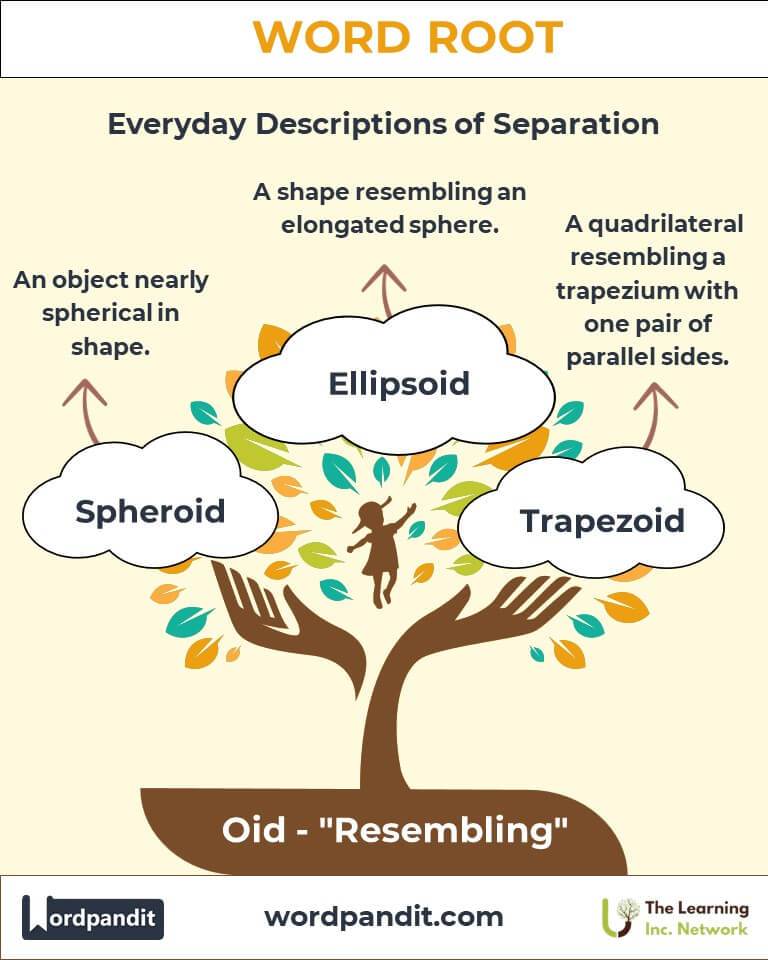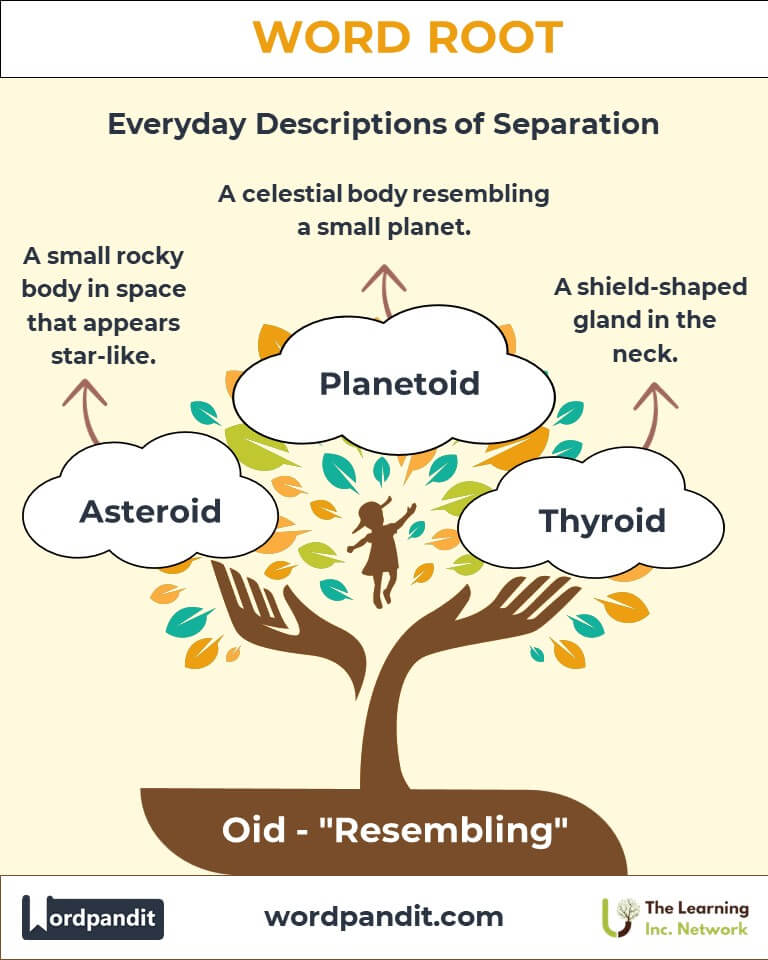Oid: The Shape of Resemblance in Language and Science
Byline:
Discover the intriguing world of the root "oid," derived from the Greek word "eidos," meaning "form" or "resemblance." From humanoids in science fiction to spheroids in geometry, "oid" helps us describe shapes, forms, and likenesses across disciplines.

Table of Contents
- Introduction: The Shape of Oid
- Etymology and Historical Journey
- Mnemonic: Unlocking the Power of Oid
- Common Oid-Related Terms
- Oid Through Time
- Oid in Specialized Fields
- Illustrative Story: Oid in Action
- Cultural Significance of Oid
- The Oid Family Tree
- FAQs about the Oid Root
- Test Your Knowledge: Oid Mastery Quiz
- Conclusion: The Enduring Legacy of Oid
Introduction: The Shape of Oid
Imagine the word "humanoid"—a figure resembling a human yet distinct in its otherworldliness. The suffix "oid," pronounced as "oyd," captures this essence of resemblance. Derived from the Greek word eidos, meaning "form" or "shape," it has become a linguistic staple in describing objects, organisms, and concepts that bear likeness to something else. Its applications span geometry, biology, and even science fiction, making it a fascinating root to explore.

Etymology and Historical Journey
The root "oid" traces back to the Greek eidos, which means "form" or "appearance." In classical philosophy, Plato used eidos to refer to ideal forms or archetypes. By the 17th century, "oid" entered scientific terminology to describe objects that resemble specific shapes or forms. Over time, it gained prominence in fields like biology, astronomy, and geometry, helping to classify and articulate the likeness of forms and structures.
Mnemonic: Unlocking the Power of Oid
Picture a humanoid robot with a human-like shape but mechanical features. The "oid" suffix helps you identify its resemblance to a human while noting its differences.
Mnemonic Device:
"Oid reminds you of form and kind, a shape alike but not confined."
Common Oid-Related Terms
- Humanoid
Pronunciation: hyoo-muh-noid
Definition: Resembling a human.
Example: "The humanoid robot could mimic human gestures and speech." - Spheroid
Pronunciation: sfeer-oyd
Definition: Almost spherical in shape.
Example: "The Earth is not a perfect sphere but a spheroid due to its flattened poles." - Asteroid
Pronunciation: as-tuh-roid
Definition: A small, rocky body orbiting the sun, resembling a star in appearance.
Example: "The asteroid belt lies between Mars and Jupiter." - Thyroid
Pronunciation: thahy-royd
Definition: A butterfly-shaped gland in the neck resembling a shield.
Example: "The thyroid gland plays a crucial role in regulating metabolism." - Cuboid
Pronunciation: kyoo-boyd
Definition: Resembling a cube.
Example: "The new office building had a modern, cuboid structure."
Oid Through Time
- Asteroid: Initially used in the early 19th century to describe star-like celestial bodies. Over time, its meaning has shifted to specifically refer to rocky objects in space.
- Thyroid: Named after its shield-like shape, the term has expanded to include its hormonal functions in medical discussions.
- Humanoid: Popularized through science fiction, it has evolved to describe robots and extraterrestrial beings resembling humans.
Oid in Specialized Fields
- Biology:
- Trapezoid: Describes a shape or bone resembling a trapezium.
- Planetoid: A small celestial body resembling a planet.
- Geometry:
- Ellipsoid: A shape resembling an elongated sphere.
- Astronomy:
- Asteroid: A term for minor planets within our solar system.
- Technology and AI:
- Humanoid: Used to describe robots designed to look and act like humans.
Illustrative Story: Oid in Action
Professor Lina was an astronomer obsessed with studying asteroids. During a late-night observation, she noticed an oddly spheroid object in the asteroid belt. "Could it be a new planetoid?" she wondered. Meanwhile, her lab assistant tested the latest humanoid AI, marveling at its ability to mirror human expressions. Their combined work in celestial and artificial forms showcased the versatility of the "oid" suffix in describing shapes and resemblances across disciplines.
Cultural Significance of Oid
The "oid" root has become a cornerstone in science fiction, shaping how we imagine extraterrestrial beings and advanced robotics. Terms like "humanoid" and "android" (a robot resembling a human) capture humanity’s curiosity about creating and encountering entities similar to ourselves. In geometry and biology, "oid" allows for precise classification, bridging art, science, and culture.

The Oid Family Tree
- Morph (Greek: "form"):
- Morphology: The study of forms.
- Form (Latin: "shape"):
- Transform: To change shape.
- Id (Latin: "appearance"):
- Idea: The representation of a form or concept.

FAQs About the "Oid" Word Root
Q: What does the suffix "oid" mean?
A: The suffix "oid" means "resembling" or "having the form of." It comes from the Greek word "eidos," which refers to form or appearance.
Q: Why are asteroids called "asteroids"?
A: Asteroids are named for their star-like appearance when viewed through early telescopes. The name combines "aster" (star) and "oid" (resembling).
Q: How is "oid" used in geometry?
A: In geometry, "oid" is used to describe shapes that resemble familiar forms. Examples include "spheroid" (resembling a sphere) and "cuboid" (resembling a cube).
Q: What is a humanoid?
A: A humanoid is something that resembles a human in form. It is often used to describe robots or creatures in science fiction that mimic human physical characteristics.
Q: Can "oid" describe living organisms?
A: Yes, "oid" is often used in biology to describe organisms or structures that resemble specific forms, such as "cricoid" cartilage or "planetoid" for small celestial bodies resembling planets.
Test Your Knowledge: "Oid" Word Root Quiz
1. What does the suffix "oid" signify?
2. Which term describes a human-like robot?
3. What is the shape of a spheroid?
4. Which field frequently uses "oid" terms?
5. What does "cuboid" describe?
Conclusion: The Enduring Legacy of Oid
The suffix "oid" is a testament to humanity’s ability to describe and classify the world’s diverse forms. From the stars in our skies to robots on Earth, it bridges imagination and science, offering precision and creativity in language. As we continue to explore and innovate, "oid" will undoubtedly shape how we articulate the resemblance of the unknown to the familiar.












